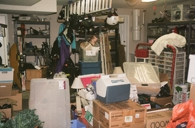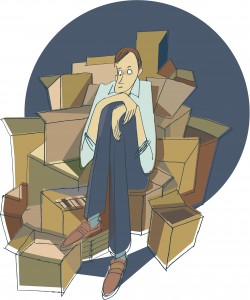
Tuesday, March 12, 2013 was National Organize Your Home Office Day, but here at Paper Tiger we like to designate the whole month of March for organizing your home office (besides, who do you know that can organize an entire office in one day?) With people working from home and diving into self-employment, home offices are quite common. It has been said that at least one in four households have a home office. With clutter on the kitchen counter, dining room table and other areas of the house, this day in particular is designated to getting the office organized.
We know this isn’t a task that can be tackled in one day, but with Paper Tiger Filing System Software for Document Management, we have a few tips that can help you make huge strides.
Optional: Since you are cleaning out your office, you might as well make sure that you are not storing documents that you no longer need or use. Your organizing system needs to be organized as well. (Surely you remember how you can’t be clean on the outside unless you’re clean on the inside). You can print the Paper Tiger File Clean-Out Guide to help you clean out papers from existing files. Also use the Transfer Report to help you physically move documents from one location to another so that your physical hanging file folders matches what you have in Paper Tiger.
These are just steps to help you get started. Of course, it would be quite difficult to clean out an entire home office in one day. Completing one of these steps a day (in order of course) can ensure a clean and tidy office in a week. Remember to relax and take your time when cleaning your office. Don’t get overwhelmed in organizing your home office. You’ll be so proud, you will want to go from room to room. Happy Organizing!
Sherry Borsheim, a Paper Tiger Expert of Simply Productive, has offered some great tips on staying organized while traveling for business so that when you’re back to your office, you won’t have a lot of ‘briefcase drama’ nor will you have a stack of papers to fumble through. You’ll be able to index them into your Paper Tiger database, and file as you’ve already noted.
Conquer Your Paper Chaos When You Travel
Has this ever happened to you? You’ve just returned from a business trip and your briefcase is bulging with receipts, meeting notes, business cards, travel documents and other essential paperwork. You’ll probably spend your first day back in the office just sorting through the chaotic mass of paper before you can even think about getting down to business!
Or, perhaps you travel all over the city attending one meeting after another. By the end of the day, your briefcase is a pile of to-dos with no particular order. Phone messages are scattered on various pieces of papers and you just know that an important message is hidden somewhere in the mess. Then there are the business cards you collected, some require follow-up, but you’re not sure where you put those important numbers. If only you had kept it in a safe place so you could remember where you put it.
At this point, all those good intentions to take action and follow-up on hot new business leads fizzle into frustration. But there’s no time to think about how you misplaced those essential items. The minute you’re back in the office you find there is a pile of emails waiting for your response, in addition to a large pile of papers on your desk begging for your attention. You dive right in to the emails and before you know it the morning is gone and it’s lunchtime. You work through lunch in order to attack the pile of paper on your desk. Then you realize you reviewed your messages, so you abandon the paper pile and listen to all your messages. It’s a never-ending circle of paper, email and voicemail, and you haven’t even cracked open your briefcase. You just spend the day reacting to emergencies and interruptions with no planned scheduled time to deal with the important issues that you had hoped to get to.
This continues day after day and you’re still dragging all those papers from your business trip in your briefcase and you’ve been adding to it during the week as you attended more meetings. Now you have no idea what’s what and it all melts together into one big mountain of paper begging for your attention. How long do you let this go on before you decide to take action? For some its days and other’s, its weeks or months. Those hot new leads you made on your business trip aren’t so hot now and the longer you leave it, the more you procrastinate on taking action. Eventually you take mountain of paper out of your briefcase and drop it on the floor by your desk and say you’ll deal with it later, because you have more important things to take care of in the office. Guilt sets in and it constantly nags at you to do something but you don’t. You know you should get your business receipts handled but you’re not sure where they all are and it ends up costing you money when you could have been reimbursed.
Here are some tips on how to put an end to the briefcase drama scenario after business travel:
1. Streamline and organize your briefcase so you know what the next action is on any piece of paper and business card while you’re out of town and when you arrive back at your office. Use plastic folders to batch similar tasks together. Remember, ease of access and functionality are very important when using any organizing product.
2. Label the file folders inside your briefcase with the next action you want to take – “Call, Data Entry, Discuss, Receipts, Meeting Notes/Agenda, Photocopy, Read, or Write”. Customize your files based on your specific action steps.
3. How to use your travel briefcase when outside your office. File meeting agendas under the file tab labeled “Meeting Notes/Agenda so when you get to the meeting it’s all together. If you collect business cards during your trip there are two things you can do with the business card: (1) enter it immediately into your Contact List, or (2) file it into your mini travel briefcase under “Data Entry”. When you return to your hotel or your office, any cards that you wanted to get into your Contact List are all grouped together. You can enter them yourself, scan them using an App or delegate the task to someone else.
4. Define the next action. No more putting it aside to deal with it later. This is what I call “deferred decisions”. Instead, ask yourself this very important question: “What is the next action I want to take on this piece of paper?
5. Schedule a specific time in your calendar to handle that next action. This is the key to getting things done. A pile or file labeled “To Do” is only an intention to do something, where as a scheduled appointment is a commitment to take action on something.
6. Use clear project folders to keep like papers together. Use these project folders to keep your agenda and meetings notes together in your mini-travel briefcase or keep them on your iPad using Evernote in a folder called “Agendas”. You may be attending several meetings and these project folders are sure to keep your papers grouped together. Do not use paper clips, they tend to attach to other pieces of paper and get caught on other paper clips.
7. 80/20 Rule – 80 percent of what we file we never refer to again. Therefore, ask yourself, “What is the worst possible case scenario if you tossed this piece of paper away?” If you can live with the results of your answer to this question, then toss the piece of paper.
8. What to file for future reference. If you decided to keep the information on a piece of paper, ask yourself: “If I want to retrieve this information again, what trigger word would you think of?” Write the trigger word on the upper right hand corner of that piece of paper and file it in your briefcase under “File”.
9. Transferring papers when you return. When you return to your office after the business trip or day of meetings, everything that you’ve gathered during your time away from the office is grouped together by the next action. Instead of a mountain of paper spilling out of your briefcase, you’ll be ahead of the paper chase game, because you’ve already defined the next action. All there is for you to do is to schedule time in your calendar to handle the actions in your mini-travel briefcase. Some of the actions like Data Entry, File, and Expense Reimburse you can delegate to your assistant if you have one. That feeling of guilt and shame won’t be there because you’ve handled what you said you would do when you returned to your office. For those papers that you need to file, you can enter the ‘trigger’ word that you’ve already written on the file into your Paper Tiger database, add additional keywords if necessary, and drop the document(s) into the corresponding item number hanging file folder.
Business Travel tips:
Implementing the business travel briefcase will dramatically decrease your stress level and increase your productivity when you return to your office. You’ll turn piles of paper into valuable resources instead of deferred decisions and guilt. Instead of reacting to emergencies, you’ll be proactive on your commitments and follow-up.
~~~~~~~~~~
Sherry Borsheim is the president of Simply Productive. You can visit Sherry, access her free article archive and grab lots of free stuff at http://www.simplyproductive.com. Sherry lives in Vancouver, BC Canada with her husband (her high-school sweetheart).
Contact Sherry for a JUMP-START on ORGANIZING your office, home and life. She will give you her trade secrets and steps to setting up your organizing systems, including recommending Paper Tiger filing system software for document management, to be organized and manage the paper files that you need to keep in hard copy format and other physical stuff in your life.
~~~~~~~~~~~~~~~~~~~~~~~~~~~~~~~~~~~~~~~

The start of a new year just passed and many people vowed to get organized. Why is organization such a big hurdle for people? Below are what we believe to be the top nine reasons people ask for help. In addition, we’ve given clues as to how Paper Tiger can solve each of these problems.
1. Overwhelmed: Have you ever felt so bogged down by clutter that you felt a spout of claustrophobia coming along? Clutter can most certainly become overwhelming, leading to depression and other gloominess. Paper Tiger is the perfect tool to defeat clutter. Instead of watching the papers and documents pile up, Paper Tiger allows you to file away each document and keep track of the exact location while relieving all stress. You won’t have to worry about finding a file again, because you’ll be able to search by any of the keywords you’ve input to find where you’ve filed the document. And Paper Tiger is not just for paper! You can index anything that you can put a number onto, and be able to get organized and clear the clutter.
2. Unawareness: There are always people that wish to get organized, but get hung up because they don’t know how to do it. While some people are natural organizers, others wouldn’t know where to begin. Paper Tiger’s indexing system is so simple to use, anyone can become organized! Filing paper in its original form, you don’t have to worry about the 1 or 2 words that you’d put on the hanging file folder tab because you can add as many keywords as you can think of into Paper Tiger’s database for the documents in your hanging file folders. You can search for whatever keyword that you’re thinking for the file you need to retrieve, and Paper Tiger will let you know where it is in seconds.
3. Lack of Resources: Some people don’t know that there are professional organizers and tools such as Paper Tiger Filing System Software for Document Management to help them get organized. Some jobs require help from others, and these professionals can advise you in just the right tools you need for the way you work and what you have to get organized. Getting organized is surely no easy deed, but knowing what to do, how to do it (a process), and the right tools to use can be what you’ve needed all along. With Paper Tiger, it’s as easy as setting a location, filing documents in that physical location, indexing or naming the items with keywords, and finally searching for the document in the search box. With the stroke of a few keys, Paper Tiger tells you the exact location of your document.
4. Tackling Organization: Many of us may want to start organizing, but can’t figure out what the next step should be. Maybe trying to start with your entire office isn’t the best move, perhaps try to clean the desk first or the bookshelf. Tasks that are too big take us back to being overwhelmed. Paper Tiger can make breaking larger tasks down much easier. Once you have accomplished smaller missions, tackling larger tasks will be a walk in the park.
5. Lack of Time: Time is always the enemy because it stops for no one. We all have busy lives with working each day, cooking dinner, and taking the kids to soccer practice, but we have to make a little time to prevent the accumulation of clutter. Paper Tiger is the best tool for time management. It takes no more that ten seconds to enter the database, file the document in a location and name it! Later on, when you go to search for that document, it takes even less time to type the keywords and let Paper Tiger reveal the precise location.
6. Motivation: Do you need a coach or guidance to help you get organized? Again, there are professional organizers who have been trained in how to do things more efficiently to help others be more productive; and can help you do this by setting milestones and regular check-ups with you. Paper Tiger can also serve as the motivator. Once you use it once and find that the document you filed six months ago is exactly where you left it, Paper Tiger will become your new best friend.
7. Surrounded by Clutter: It’s an awful thing when you tidy something and someone else comes right behind you and creates a mess, isn’t it? Some people get discouraged from organizing because others around them are jumbled. The real beauty of Paper Tiger lies in the keywords. You call it “Nissan car note”, he calls it “car bill” but if all these keywords are saved in Paper Tiger, both parties can find documents with ease. Getting others around you organized will be easy because everyone can still find the documents.
8. Health Concerns: Attention Deficit Hyperactivity Disorder (ADHD) and other disorders can definitely bring organization to a screeching halt. Getting lost in thought and starting tasks but never finishing them can be very frustrating, due to no fault of their own. Attempting to declutter one stack at a time is a great milestone towards getting organized. Paper Tiger allows those unfinished tasks to be filed away for safe keeping until they are ready to be worked on again.
9. Change: We all go through changes. Marriage, new baby, our children will pack up and leave for college or we’ll move. Whatever the case may be, these transitional periods often call for reorganization. Paper Tiger is the perfect tool to help overcome these changes and stay out of the realms of clutter. Use Paper Tiger with storage bins to keep up with items that aren’t needed for immediate use. See just a few things that Paper Tiger can help you organize on our Not Just for Paper webpage at http://thepapertiger.com/tour#4
The struggle to get organized is one that can be conquered with the help of Paper Tiger and/or professional organizers. Virtually any obstacle one encounters when trying to get organized can be solved with Paper Tiger Filing System Software for Document Management. Next time you hit a snag when trying to get organized, think about how Paper Tiger and other organizing resources can help make organization easier.

Each year we hear the same new year’s resolutions over and over again, “I’m going to exercise more this year” or “I’ll be nicer to my family this year” but sadly most of us drop these resolutions within the first ninety days of the year. One of the most popular resolutions that people make is to get organized. The National Association of Professional Organizers (NAPO) caught wind of this and named January “Get Organized Month” or “GO Month”. They started this initiative in 2003 to help people with organization and productivity. According to NAPO, the bulk of their clients request help with organizing their home offices. It’s safe to assume that clients are referring to paper clutter in the office. Paper Tiger Filing System Software is the perfect tool to get 2013 started off on the right foot if you were planning to be more organized this year.
- Efficient: Paper Tiger can help one file and organize all paper and digital files. Once you really catch on to the concept of indexing paper files and setting up locations in your database, you won’t know how you were able to organize without Paper Tiger. And since Paper Tiger isn’t just for paper, imagine all the other rooms of the house that you can organize. Paper Tiger’s basic concepts will help you master the software in a matter of minutes; bringing your organization troubles to an end, making it easy to keep your resolution for the entire year.
- Versatile: Paper Tiger not only helps you to organize and actually find paper files, but with Digital Tiger, powered by Google Docs, you can also find digital files! Using Google Docs as your digital file storage location, you can access scanned documents such as PDFs and also other types of documents. Google Docs gives users five gigabytes of storage free to store your digital files that you want in the cloud. Using Google Docs allows users to easily share digital files and even access them from mobile devices. Digital Tiger is a free add-on with a paid Paper Tiger Online Basic or Pro account for now, and is the function that connects your Paper Tiger Online account to your Google Docs/Google Drive account, then you will be able to search from Paper Tiger to find your paper/physical items that you’ve indexed into Paper Tiger’s database and your digital files that you’ve created, scanned or uploaded to Google Docs format through a Gmail or Google account.
- Practical: Paper Tiger may be one of the best investments ever as far as time is concerned. How much time do you think you waste on average looking for something? Each year people waste hours and entire days looking for something. Experts estimate that people waste 150 hours per year searching for lost items. Calculate your cost of disorganized here. A small investment in Paper Tiger will save not only time but also money. How many times have you paid a bill late because you lost it? Every time a document is filed and indexed into Paper Tiger, you can feel sure that you will be able to find it again quickly and easily. The days of trying to figure out where a document was left are over! With Paper Tiger’s search engine like feature, a few keywords will help you find exactly the document needed.
If organization was at the top of your New Year’s Resolution list, look no further; Paper Tiger is here to help. Its resourceful system will be so easy to use, it will be hard to stop organizing! The ability to organize both digital and paper files will not only clear up clutter on the desk but also inside the computer.
During this “Get Organized Month,” take advantage of the expertise of one of the productivity consultants that are Paper Tiger experts who can help you work more efficiently in every area of your life. They will work with you either virtually or in-person, whichever you need, and will help you to get organized and create a customized system for the way you work.
Finally, all the time and money wasted from disorganization will be returned on your simple investment in Paper Tiger, and you’ll be able to keep at least one new year’s resolution.
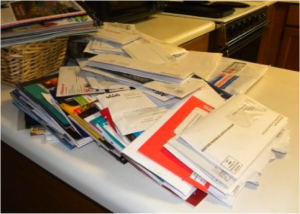
The kitchen counter is a magnet for clutter. It’s the same routine everyday: set mail on the counter; pull out recipe card for chicken cacciatore; jot down telephone messages; flip through new magazine, clip a few coupons. After doing all of that, the kitchen counter is a mess and the disorder only grows with each passing day. Where is the electricity bill that’s now three days overdue? Did you read the letter from your pen pal in Peru?
Finally, gain back your peace of mind with Paper Tiger Filing System Software and Document Management. Not only can Paper Tiger help make your countertops visible again, but also neat and organized! Here are three ways Paper Tiger can help you minimize clutter in your kitchen.
Open Mail - It’s a hard habit to break, setting the mail down without looking at it upon arriving home. How can we organize with Paper Tiger if we don’t know what we have? Open the mail as soon as you get home. Junk mail? Trash it! With Paper Tiger’s easy database and locations, important documents or keepsakes received in the mail can always be easily filed and found. Paper Tiger’s indexing system allows you to conveniently file paper in its original form; no scanning is required! Set a location for your hanging files and in Paper Tiger, index your paper files using keywords for important documents, from your medical, tax or education records. Keywords remove the hassle of naming a document and trying to remember it. Find your documents with ease through Paper Tiger’s effortless search box!
Sort Through Bills – How many times have you racked up late fees on a bill that you couldn’t find? It has been said that 23% of adults pay bills late and incur fees due to lost statements. Are you a part of that statistic? It’s very easy for bills and monthly payments to slip through the cracks. Of course, Paper Tiger won’t pay your bills for you, but with a little bit of work on your part, Paper Tiger can help your pennies add up. Sort through bills and figure out which ones need to be paid immediately and which ones aren’t as pressing. You may even have an “Urgent” location in Paper Tiger to help you deal with bills that aren’t quite ready to be permanently put away. The “Action Date” feature will assist you with time-management. Watch late fees disappear as Paper Tiger helps clear clutter simply by having a place to file your papers and a system to be able to actually find them again. Finding past statements will never prove impossible again!
Shelve Cookbooks and Magazines – Cookbooks and magazines are great to look at, but they deserve a home. We already know that Paper Tiger is not just for paper filing and document management. Cookbooks can take up quite a bit of space and cause disorder. Use Paper Tiger to number the spine of each book and choose a location for quick reference. Keywords can help you find different cuisines. Recipe cards can also be easily organized. Classify the similar recipes together and choose a location for them. Again, use keywords to help you easily find various recipes. Panang Curry tonight and Homemade Lasagna tomorrow is an easy feat.
Can you remember the last time you were able to sit and enjoy a whole magazine? Maybe you prefer to clip tidbits out the magazine that you find interesting, or maybe you like to tuck away the book for further reading. Whatever your preference, Paper Tiger can make sure magazines aren’t on your kitchen counter, but put away for your leisure when suitable. Index the entire magazine using the straightforward labels or index your clippings in hanging file folders.
Utilizing Paper Tiger paper filing system software in just these few ways will have your countertops cleaner. Of course, there are other things on the counter, but minimizing paper is a gradual process. Follow these few tips as a start and Paper Tiger will have your entire home organized before long.

You most likely loved how many shelves your home had when you first moved in. With all good intentions, little did you realize the amount of clutter that would accumulate on those shelves. In fact, it may seem like the shelves have become a magnet for clutter seeming to attract things you did not even realize you owned. Even those items you wanted to showcase on the shelves now seem to be lost in the shuffle.
Of course, there are a couple of reasons for clutter, so first let’s think about why clutter accumulates.
But there is a solution with Paper Tiger Filing System Software for document management! You can now finally take the clutter off your shelves, create a home for each item, and enjoy the look of your shelves again, and be able to find them when you need them. Let your shelves return to being decorative, not just functional. Even if you want them functional, but more organized, you can still accomplish this as well.
It’s no magic trick or even that big a secret. The best way to declutter your home is to use Paper Tiger, which is an indexing system to help you get organized. Paper Tiger is not just for paper filing and document management!
You may be proud to have the biggest movie collection this side of Hollywood, but getting a little tired of it taking over your shelving space. Or maybe you have an extensive collection of DIY books you refer to often, but would rather not have them taking over all of your shelving space.
Whatever the items may be, you can still regain control of your home or office again. The best part isn’t about simply letting go of half of your collection to make it happen. It is, however, about creating a home for everything or packing these items up into storage bins. Don’t panic! You will still be able to find what you need by indexing the items into Paper Tiger’s system.
Choose the items you know you need to have on hand that you use the most often, and organize them in a neat and attractive way on your shelves. The remaining items can be packed into bins or another appropriate place. Then in Paper Tiger’s database, you simply type item the name or description and keywords for the items that you’re organizing in each bin or box or other ‘home’. Later when you want to find a particular item, you can simply conduct a search based on the keywords you’ve entered into the database, and you’ll be able to find exactly which bin or box number to find it in.
This is especially handy if you are going to keep boxes stored in the garage, attic or an offsite storage facility. It is even more crucial to use Paper Tiger if you are going to have these boxes or bins located in multiple locations. By making a note of where each numbered box is stored, you will be able to find the item you are looking for, the bin number to find it in and where that bin is located.
So let’s say that you have magazines stacking up on your shelves. Decide if you’re going to keep all of them or some of them. Throw away or recycle what you’re not going to keep. For those that you want to keep for reading later, find a home for them. Depending on how many you will keep, you may want to file in a hanging file folder in your file cabinet. Then schedule time on your calendar to go through one or two at a time until you’re caught up. Think about cutting out the articles you want to keep on file instead of keeping the entire magazine. You can enter the article title and keywords and/or a description of the article into Paper Tiger’s database, then drop the article into the hanging file folder to match the item number in Paper Tiger.
How do you organize seasonal decorations when putting them away after a holiday? Give your decorations for each ‘season’ or ‘holiday’ a home of their own as in the example below.
Of course, this could apply to any type of item. For instance, you may have a large collection of tools that you need to keep track of. In Paper Tiger’s database, you might name a Location “Workshop”, and in this Location, you can index the list of tools in your workshop, what tools are in what drawer, and what tools are hanging on the wall, and what tools are in the cabinet with doors, etc. So anyone in your family will be able to search the database and know exactly where you keep the drill and the drill bits, and they will know exactly where to put them back!
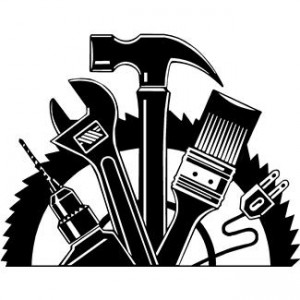
Where is all this stuff!?!
The bottom line is that once you use this simple system you can reclaim those shelves in an organized manner, whether your shelves have stacks of paper files, or books, or decorations, or tools. When you bring new items in, include them in Paper Tiger’s indexing system and you can always keep those shelves clutter free. When you declutter and get organized with Paper Tiger, you’ll know where everything is so you can easily retrieve what you need, when you need it!
This article by Michelle Panzlaff, and the newest Certified Paper Tiger Expert, gives some great tips in paper filing and purging, and how to organize your paper files so that you can stop the paper clutter. Michelle also recommends Paper Tiger Filing System Software for Document Management to get everything in your life organized — not just for filing paper!

Paper clutter is a real challenge because of the volume of paper we all seem to accumulate. It’s just a fact that pieces of paper easily stack and hide each other.
Here are some quick tips to help you purge your paper clutter and get organized!
Look for related paper files and gather them together.
You’ve done this a million times: sorted through a stack of papers and divided them into small stacks, such as Bills to Pay, Bank Statements, School Papers, To-Do Lists, Ideas You’d Like To Try, Things I Might Buy, and blank yellow pads. But you probably stopped there. Keep going through the next three steps, and you won’t end up re-stacking all those papers, only to go through them again later.
Dispose of unneeded or duplicate items.
Did you find duplicates, or old documents you no longer need? Toss them!
Examples: Expired warranties, magazine articles that you kept but can’t remember why, information that you could easily find again, financial statements whose information is repeated on later statements. Make sure to shred or destroy properly.
Choose appropriate containers for each stack.
After you have purged and you know what you are going to keep, take a look at each box or stack of papers and consider what kind of container will work best. File folders are a natural, but consider other alternatives where appropriate:
Three-ring binders can be stored on shelves, and contents can either be hole-punched or placed in pockets and page protectors. (TIP: have a hole puncher in reach at all times if you go this route.)
Box-bottom folders handle bulkier items well.
Large envelopes can substitute for file folders if you don’t have a filing cabinet or if the papers are various sizes and apt to fall out of a file folder.
For voluminous stacks, you don’t need to organize further, try a box. If you do need to further organize a big stack, think about an accordion file or a notebook with dividers.
(TIP: whatever options you are considering, ‘do’ think long term on how it will work for you before you go to set up.)
Choose a home for each container.
If you use it a lot, it needs to be in your reach! Store frequently used papers in convenient locations. You might also locate files easier if you line up all the tabs on hanging file folders in a straight line, rather than alternating from left to right. (TIP: Decide on what side to put ‘Main Category’ header tabs and keep them in a tidy row too. It makes for easy scanning later.)
And remember that as you have new papers that need to be filed, take the time to label them properly, index them into Paper Tiger, and place them where they belong sooner than later. If you ‘Put it here FOR NOW’ you are asking for trouble later! And those stacks of paper will start piling up again.
Floating Pieces of Paper/Notes
Eliminate floating pieces of paper by having only one place to write things down. Be sure to identify a home where it will always be kept as well. You may keep your notes in a notebook that stays by the phone, a small pocket notebook that you carry in your pocket or purse. Or maybe a note-pad on your Smart Phone that you know is always going to go with you.
Just follow this rule… never jot something down with the idea that you’ll rewrite or type it in later. NOW is the time. ‘Putting stuff here for now’ is how we get into trouble in the first place, so write it down in its permanent location to start with, and you’ll be saving time also.
Original article posted at ‘Oh my, it’s paper, paper, paper everywhere!‘
~~~~~~~~~~~~~~~~~~~~~~~~~~
Tidy Tiger Solutions
Michelle Panzlaff
To Michelle, serving as a Professional Organizer is all about creating more functional and enjoyable spaces, productive workflow and effective filing systems, while helping clients feel inspired and more productive.
As a skilled professional, Michelle now possesses over 23 years of office, service and administrative experience. Michelle relies on her exceptional skill set to solve complex challenges for her residential and business clients alike.
Phone: (778) 866-6942
Email: info@tidytiger.biz

How many times in your day do you find yourself shuffling through paper files, wasting a lot of time looking for one item in particular that seems to be lost in countless papers in front of you? This has happened to all of us at one time or another, whether we are in busy offices or just trying to keep household paperwork in order.
Getting organized will reduce stress in your life and help you be more productive, and an effective filing system method, like Paper Tiger Filing System Software for document management can help get your life in order, both personally and professionally. Think about how much time you could save and how much more you could do if you’re not always searching for things.
It is said that the average American spends over 150 hours per year, just looking for lost information. Some estimates are even higher than this! How much does lost information cost you and your staff?
The problem often is, once you have a disorganized system, it can be difficult to get out from under it. Many people claim to have a “method to their madness” or that the filing system they have in place, with random papers stacked on every flat surface of a room, “works for them.” Truth be told, though, this most likely isn’t true and they waste a lot of time searching to find what they need.
It takes more effort to deal with clutter and spend time trying to find documents and other physical items than it would if you had a system in place. Besides, if someone else had to work with that same system, he or she may not be as able to adjust to the madness. Also consider the stress having this type of home or office causes. Even if it is subconscious, people who live with clutter in their home or office life are reported to feel stressed out, depressed and generally overwhelmed all of the time.
It is easier to start off organized, but even if you have already started to live in or work in a world of paper chaos, you can still change things and turn it around. If you’re not organized, there is hope. Paper Tiger is a great tool to get you started on your way to filing and being able to find what you need, as well as make it simpler to get an organizational system into place and then maintained. Paper Tiger is flexible enough to fit your needs and preferences.
If you have done any filing, you most likely know that some documents can be filed under different file names, for example you might file your “auto” records but someone else is looking for “car” records or even “vehicle” records. It almost doesn’t matter how pretty the system in place is if you have to look under 3 or more hanging file folders to find the file you need. It is also very easy to duplicate files, having some documents under “auto” and some under “car” and “vehicle” so you’re still wasting time and file space in this instance.
When you use Paper Tiger Filing System Software for document management, you can use keywords so that any one of these terms could be typed in to search for the location of a document. It keeps everyone who has access to the filing cabinets and the filing system software on the same page.
If it can be numbered or indexed, it can become part of your filing system. This very same program you use to get your papers in your home or office in order can be used to keep your books or garage or storage shed in order as part of your effort to get organized. Imagine a life free of clutter and finally making sense when it comes to how things are organized. So, you keep tools in the garage, basement, the backyard shed and an offsite storage rental unit. Because of that, how will you have any idea of where to find what?
No more lost items! Doesn’t that sound good? All you do is take the time to enter the item names and keywords relating to the items you are organizing; indexing them into Paper Tiger’s database, whether it be paper, books, CDs, DVDs, collectors’ items or tools, or anything else you can put a number onto. Then when you need an item, you can conduct a quick Google-like search in the software database and find any of your belongings at the time you need them instead of having a time-consuming search. Implement Paper Tiger Filing System Software for document management and see for yourself how quickly you can get organized!
Don’t let the idea of getting organized overwhelm you. Asking for help can be a sign of wisdom, not weakness. If you were not born organized, or if you haven’t thought about getting some training in how to get organized or be more organized, then give yourself a break!
Ask someone in your family or a friend that can help you. Hire an intern. Or better yet, organizing and productivity consultants are available to help you create a customizable work flow and help you implement Paper Tiger so that you can get organized and work more efficiently. Click here to see Paper Tiger Experts who can help you.
Sherry Borsheim, a Paper Tiger Expert of Simply Productive, has published a short video to help us understand that ‘going paperless’ is a process, and may mean that you have ‘less’ paper, instead of ‘no’ paper. Not necessarily that you have to get rid of every piece of paper to go paperless.
Sherry’s Organizing Bootcamps will give you a JUMP-START on ORGANIZING your office, home and life. She will give you her trade secrets and steps to setting up your organizing systems, including recommending Paper Tiger filing system software for document management, to be organized and manage the paper files that you need to keep in hard copy format and other physical stuff in your life.

Sherry says,
Making the decision to go paperless is a great step in the right direction. But it isn’t a single step … going paperless is a process. Even after I thought I had cleared everything, I still find it is important to keep going back in and clearing more out! Staying organized is about staying on top of your systems.
~~~~~~~~~~~~~~~~~~~~~~~~~~~~~~~~~~~~~~~
With the stress of everyday, trying to keep up with all the activity around us, whether it be play or business, try to follow at least one of these tips in the next month to help you declutter. This guest post by Jana Bain of HomeInsurance.org is a great start in de-cluttering your home. From kitchen to bath, from closets to garage, doing a little at a time from each section of your home, will make a big difference in how you feel. Clutter can sometimes make us feel so overwhelmed.
Depending on the level of clutter you have, you might not want to tackle the biggest job first, but start small and work your way through.
Make a list that you want to accomplish, then schedule one job on your list each month. Before you know it, you’ll be feeling better with less clutter and you’ll be saving time because you can find things again.
You’ll note below that we’ve inserted some Paper Tiger Filing System software tips that will also help you find things when you need them.

It has been said that one person’s trash is another person’s treasure, but how much “treasure” can our homes hold? Over time, keepsakes and everyday items accumulate and become clutter, taking up valuable living space. Nineteenth-century philosopher Henry David Thoreau has urged us to “simplify, simplify,” and failure to do so when it comes to home organization will eventually result in living environments reminiscent of what you may see on an episode of Hoarders: Buried Alive. The de-cluttering process may be a daunting task, but think about the time you could save by organizing your home. Here are eight surefire ways (according to each room in your home) to help you manage and refresh space effectively.
There are countless items in the kitchen we have collected through the years that end up not being used at all. If you’re not sure what you use and what you don’t, a true way to find out is to gather all utensils and cooking gadgets into a cardboard box. For one or two months, put all the items you have used into a drawer. All the items that remain in that initial cardboard box are underutilized and you’ll have to reevaluate if you should hang onto them, or pass them along to charity. Sure, there are those items we use once in a blue moon for baking or for a specific purpose, and those items should be stored away, making room for things that are used more often.
For longer-term storage, this is the perfect place to store those seasonal items, such as sporting equipment and holiday décor. A common mistake is that people store these items with no consideration to organization or labels, which makes it more difficult to sort through when you do decide to utilize these items. Labeling boxes, bins, and containers so that items can be instantly located is a great way to keep things in their place rather than having random stuff pile up.
[You can use Paper Tiger to index the items that you place in the boxes or bins. When labeling the containers, label them to coincide with the item number from Paper Tiger. Anyone in your home can search Paper Tiger's database when they need to find something, and know exactly which container the item can be found in. In addition, you'll know where the item should be placed when it needs to be put away because it has a home of its own!]
Some of us have stocked up medicine cabinets with plenty of personal care products but this isn’t always a good thing. All personal care products and medicines have an expiration date, which should be purged once in a while. A good rule of thumb is that most makeup goes bad after six months; the closer the product is used to the eyes, the shorter the lifespan. Go through all your vanity products and medicines and get rid of those products that have hardened, softened, changed colors, or expired.
A common culprit of cluttered home offices is massive buildups of paperwork. If you are uncomfortable with discarding or shredding some past paid bills, or need to keep them for your records, make sure they are organized and take up little space. For example, filing away documents in expanding files, or investing in a digital scanner and filing system, is a great way to transform paper documents into a more accessible electronic form. Twelve-month expanding files are also very useful when it comes to deciding which bill receipt you should throw or shred. When you pay for bills, like say in January, place them in the January section for a year later. If you haven’t even looked at the document, you probably don’t need it.
[You can use Paper Tiger to index the paper files that you need to keep in hard copy format. How many files do you have that you just really don't know what to name it? No problem with Paper Tiger because you can add as many keywords into the database as relates to the documents you have in any file folder! When labeling your hanging file folders, you would label them to coincide with the item number from Paper Tiger. Type in the database an item name and any keywords that you want to, then drop the documents into the corresponding file folder. Anyone in your home can search Paper Tiger's database when they need to find a document, and know exactly which which hanging file folder it can be found in. Again, you'll know where the item should be placed when it needs to be returned to file because it has a home of its own! You also won't have to worry about duplicating a file]
You probably own a lot of clothes you never wear, or no longer have use for. Use this system to determine which clothes you should toss or donate: for six months or so, turn all the clothes in your closet facing back-to-front. When you wear an item, return it to the closet with the hanger facing the right way. If you try it on but don’t end up wearing it; make sure you put it back with the hanger still facing backwards. Chances are, you’re going to discover you own lots of clothes you don’t wear often or at all. Store away clothes you wear on rare occasions, or donate them. It’s better that someone else finds use for them.
Excess movies, books, and old gaming systems tend to sit and gather dust. We keep certain items because of the sentimental value, so here’s a surefire way to compromise, using the ratio-reduction rule of thumb. For every four or five items or old DVDs you decide to keep, remove one you could do without. This sort-and-purge process seems to work well if you can increase the ration to, say, three-to-one, which will really clear up some space for new possessions. This goes for old magazines, knickknacks, and toys.
Rooms frequented by little kids are typically clutter-intense zones, but you can help them keep toys and play items organized by designating some “clear zones.” Sort items and store according to a specific activity like painting, reading, and studying, with labels for each area of use. When you involve your kids in this sorting process, they will be able to identify and keep up with where everything should go in the future.
[In the same way that you can label boxes or bins in your garage, you can use Paper Tiger to index your movies, books, paints or other hobby items and label the containers for each to coincide with the item number from Paper Tiger. You'll always know where to find "Star Wars Episode V The Empire Strikes Back" and where to return it when you've watch it again!]
We all have that cabinet or closet for our cleaning supplies, dusting items, and general disinfectants, but if they’re all piled up, it’s hard to tell which products are old or for what use. You can sort out all your cleaning products by using vertical space for storage, leaving more floor space. A good shelving system should do the trick to help stow the items you use on a regular basis. Keep in mind that just because you have space, it doesn’t mean you should overcrowd it.
See the following blog articles for specific examples in how Paper Tiger Filing System Software can help you declutter and organize your home!
Stephanie Calahan, of Calahan Solutions and a Paper Tiger Expert shares 3 great tips in this article to eliminate the avalanche of paper piles. Be sure to watch the video she mentions later in this article to help you create an action system that works for you!
Stephanie recognizes, as we do, that different people need different tools to help with their daily lives, including Paper Tiger Filing System and Document Management Software, which she recommends based on her clients’ needs and the way that they work. She understands that every person is different and requires systems that work for them.

Your desktop, and frankly any other horizontal surface, are the hardest places to keep clear of paper. Bills to pay, to-do lists, event invites, magazines you have been meaning to read, orders you need to fill, and the list goes on and on.
Often, we keep things “out” – either spread around or stacked – on our desk and other surfaces because we don’t want to forget to do something that we have deemed important or don’t want to forget.
Today I’ll share 3 tricks that have worked for me and my clients.
Rather than thinking of your papers in terms of a topic or a list of things that you need to do, think in terms of “next action.” You may have many things that ultimately need to happen with a particular piece of paper, but by only thinking of the next action, you can eliminate overwhelm and process your paper faster. (If there is no action necessary, skip to trick #3)
Once you have determined the next action, either write it directly on the paper, or attach a sticky note to the page with the next action you need to take. If you know the information, also write down how and when you will best perform that action. By writing down the action you need to take, you will save yourself loads of time later when you pick up the paper again! Why rethink about an action over and over when you can decide once and move on?
Example: I was working with a client the other day and we were going through his paper work. He picked up a piece of paper that contained a name and phone number of a contact. He told me that his next action was to make a phone call to that person for a project they were working on together. I then asked him if he had everything he needed to make the call successful. No. He didn’t. He had to do some quick research first. So, the next action was not the phone call, it was the research.
When you have action items, it is OK to mix various project or topics as long as they are organized by the type of action you need to take.
Create an Action System! Action Systems come in a number of different forms. One way is to label file folders with each Verb and store your papers in those file folders on your desk in a vertical file holder (the graduated kind where you can see all of the file tabs is best) or you could use the Pendaflex PileSmart Organizer. This way, the items are stored in an orderly fashion until you make time to take action. You might have something like this:
– Call
– Write
– Review/Decide
– Pay
For a detailed look at how that might work for you, check out the video I did on YouTube a while back – Creating an Action Filing System for the Way You Work.
The Action System is great to keep things looking neat, but you must actually open the folders and take action to get the full benefit! By taking action by verb or type of action, you will eliminate multi-tasking, save time and increase concentration. If possible, it is best to empty each folder in one sitting. Once you have completed the action, ask “What is the next action?” and file accordingly.
Example: The paper my client had identified with the contact and phone number originally went into a “Research” folder. Once he had completed the research, he added that information to the paper and moved the page from “Research” to the “Call” folder. When the call was complete, he would either toss the paper, or file it into permanent reference or assign it a new action based on the results of the call.
Sometimes we keep papers on our desk because there is information that we want easily accessible but there really isn’t an action needed. Start by making sure that the information really is needed for quick reference. If you don’t need the information on at least a weekly basis, file it away in your permanent reference files.
The fastest way to create a quick reference system is to get a 1 – 1 1/2 inch binder and a numbered tab system. Either 3-hole punch each page or put them in sheet protectors. Each topic gets its own number. At the front of the binder, have an index to tell you what each number represents. You might have something like this:
1 — Emergency Contacts
2 — Service Providers
3 — Passwords
4 — Product Codes
and so on.
Once you have your Action System and Quick Reference system in place, it is a matter of consistently asking yourself “what is the next action” and then processing the paper. These small decisions will help you keep the paper piles under control and eliminate avalanche concerns. Before you know it, you will be getting things done rather than pushing papers around your desk!
If you would like help getting all of your paper piles figured out and systems put in place that match the way you think and work, let’s talk!
To your success!
About the Author:
Stephanie Calahan is The Business Vision Catalyst and founder of Calahan Solutions, Inc. She works with purpose-driven entrepreneurs, visionaries, coaches, consultants, health practitioners, authors, speakers and all sorts of remarkable service professionals who are experts in their field, to help them embrace their brilliance, leverage their business and get their message out with power, ease and joy; so that they can make a powerfully positive difference in the world, exponentially grow their income and enjoy a highly-successful and meaningful business… while working less. Learn how you can have more freedom in your life! http://www.StephanieCalahan.com
This article by Sherry Borsheim, a Paper Tiger Expert of Simply Productive, gives us some great advise on planning our organizing project. Below are three project planning tools and strategies you can use right away to break free from organizing paralysis to finally get organized.
Also check out Sherry’s Organizing Bootcamps that will give you a JUMP-START on ORGANIZING your office, home and life. She will give you her trade secrets and steps to setting up your organizing systems, including recommending Paper Tiger filing system software for document management, to be organized and manage the paper files that you need to keep in hard copy format and other physical stuff in your life.

At some point, you may have started organizing your office or a room in your home then you freeze up and walk away because it was just too overwhelming, you feel exhausted by the process, don’t feel like you have the project planning tools you need, or you weren’t sure where you were going to put all the stuff. This is what I call organizing paralysis.
Take a step back from your organizing project and realize that, just like gaining weight, it didn’t happen overnight. It was a slow progression over time of accumulating papers, books, magazines, business cards, receipts, supplies, gadgets, clothes, kitchen appliances and so on. Therefore, getting organized will take time to sort through all your piles and you’ll be making a lot of decisions on what to keep, what to donate and what to let go of.
People who want to be organized realize that the current situation is not working for them and they want to make a change for the better. They desire a different experience. Getting clear on your purpose and ultimate outcome for being organized is the first step.
Ask yourself the following questions:
Questions are great project planning tools. Answer these questions and you will be clear on why you want to get organized in the first place and secondly, this will be your motivation as you sort through your things.
Here’s a few of examples of what to get your creative juices flowing:
“I want to walk into my office in the morning to see a clean desk and have a plan of action for the day. Everything has a home and I have space to be creative.”
“I want to have client meetings in my studio, they will see that I’m am organized and able to take on bigger client projects.”
“I want easy to maintain systems in my home and office. Family members know where to put things away and I’m not embarrassed to have people over.”
If you say you’ll get to it later or someday, the piles will continue to grow because later never comes. Decide to take action now and make a commitment to get your organizing projects complete. I’ll often say to my clients, “An item on a to do list is not a commitment at a specific time. When you scheduled an appointment in your calendar, it’s a commitment to get that task done.” That’s one of the reason clients like working with a Professional Organizer because they have a scheduled time on their calendar for the session. I know it sounds simple, but most people don’t schedule time to get organized.
To move your organizing projects along at a steady pace, schedule 1 to 3 hour sessions at a time. Set a timer, play motivating music and have a glass of water or tea on hand. There’s something about knowing the timer is ticking and the countdown has begun. It’s a great motivator and will help you to stay focused. Don’t underestimate your scheduling calendar, it is a powerful project planning tool.
Having the right project planning tools and setting up a staging area is key to your success. If you were inviting friends over for dinner you would plan what you were going to serve, buy the groceries and then prepare the meal. The same applies to your organizing project. Designate a staging area for items to donate, recycle, shred, garbage and for other rooms. Gather some boxes or bins for sorting and grouping like things together, use garbage bags for items you are donating and for items you may want to sell.
During the organizing process, you may find that it gets worse before it gets better. But don’t be discouraged, stay focused and pretend you have a scheduled appointment with me, your Organizer. During each of your organizing sessions, state what you want to accomplish by the end of the session upfront. Then work towards that goal. That’s what I’d be doing if I was with you.
~~~~~~~~~~~~~~~~~~~~~~~~~~~~~~~~~~~~~~~
P.S. Clear Out Your Clutter Day is this month! (Saturday, May 19th) It’s a live free virtual event where women around the world are clearing their clutter. You log on from your home or office throughout the day for tips, tools, inspiration & motivation. AND you get access to Sherry for the day! There will be a surprise bonus offer for those who register and attend!
Get the details for Sherry’s Simply Productive Clear Out Your Clutter Day and register at:
http://www.simplyproductive.com/clear-out-your-clutter-day/
~~~~~~~~~~~~~~~~~~~~~~~~~~~~~~~~~~~~~~~
Sherry Borsheim is the president of Simply Productive. You can visit Sherry, access her free article archive and grab lots of free stuff at http://www.simplyproductive.com. Sherry lives in Vancouver, BC Canada with her husband (her high-school sweetheart).
Contact Sherry for a JUMP-START on ORGANIZING your office, home and life. She will give you her trade secrets and steps to setting up your organizing systems, including recommending Paper Tiger filing system software for document management, to be organized and manage the paper files that you need to keep in hard copy format and other physical stuff in your life.
Reprinted with permission:
Original article posted at http://www.simplyproductive.com/2012/05/my-project-planning-tools-to-stop-organizing-paralysis/
~~~~~~~~~~~~~~~~~~~~~~~~~~~~~~~~~~~~~~~
This article by Natalie Conrad of Organized Habits, and a Paper Tiger Expert, lists a few of the reasons behind why clutter piles up in our lives; and how to get started on a system for moving forward to get organized. Natalie also recommends Paper Tiger Filing System Software for Document Management to get everything in your life organized — not just for filing paper.
I was helping a client recently who has a beautiful home. Everything seemed to have its place and the home was very warm and inviting. I was asked to help with the home office. The office had a desk piled with papers, bills and receipts as well as boxes of more of the same tucked under the desk. I have seen much worse than this, but my client was struggling to get the home office organized and back into a functioning room. As we began to work, we talked about the reasons for the room’s unorganized state. There is always a reason behind the clutter. I am not saying this so that we can justify the clutter, but to help us recognize that there is something behind the physical clutter we see. Below are a few examples of the reasons why people now have clutter when they used to be able to handle it.
All of these reasons have something in common; change and transition. This is a very common trigger for many of us that causes a once under-control home to become cluttered and less functional.
“Every time we go through a major change,
we experience a breakdown in our organizational systems.”
~ Julie Morgenstern
Periods of transition, such as the ones listed above, require that we give ourselves time to adapt and adjust and then rework our organizational systems to be more in line with our new, current reality.
“Our life is not static and neither are our organizing systems.”
~ Natalie Conrad
In other words, give yourself a break. You are going through, or have just gone through, a transition. Once you feel the earth is a little more solid under your feet again, then get some help and get back to being organized. Tweak your old systems or set up a new organizational system.
But here’s the thing – start with the present. Don’t try to go back through all the things that were “let go” during your transition. Deal with the things that are presently coming in the mail, the projects at hand, and the bills to be paid this month. Set up a system to manage today and if you have time, go back and straighten up the past later.
If you need ideas on how to get started on being more organized now that you’ve gone through a transition, keep reading Natalie’s blog for ideas to get you started. Use the “search” function and key words to get help for your particular situation or room in the house. You can also leave a comment for her and pick her brain a little!

We also found this great video by Natalie on her blog that gives great tips in how to set up an action file system for your day to day paper files. Click here to watch how simple setting up your own system can be! Of course, you can always call Natalie to get her help on the more overwhelming clutter situations in your life.
Natalie Conrad is an organization consultant, speaker, and author in Northern California. She is also the founder of Organized Habits, a premier organizing firm, serving national and local clients in homes and small business settings. She is passionate about organizing as she believes that the clutter holds one back from pursing their life long goals and dreams. Visit Natalie’s blog for more articles like this by going to www.OrganizedHabits.com/blog
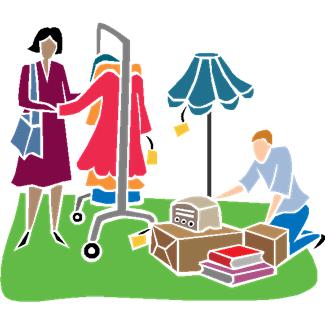
You keep meaning to get your home and office in order so you can enjoy organized living; it just keeps getting put off. The idea of trying to organize everything and de-clutter seems like such a daunting task, even though you know it will make you feel much better and less stressed in the long run.
There are all those paper files, books, training binders, DVDs and video games to straighten up. When you need to find a book, it takes more time than it’s worth to find it! There are winter clothes to move to storage and summer clothes to fetch, if you can remember which bin in the basement that you’ve put them. You also have that collection of NASCAR souvenirs or another treasured collection, some to showcase and some to store for safekeeping.
The good news is that you no longer have to put it off. By implementing Paper Tiger Online filing system software, you can now de-clutter and feel confident to put things in their own place and be able to find them again when you need them. It will be so worth the time invested to get organized, because you won’t be wasting time afterward with time-consuming searches for needed items.
Paper Tiger can be used for paper files, but also for many other physical items. Anything that you can put a number onto, you can index with your filing system software. This is especially important for items that may be kept in more than one location. So, for example, if you are going to keep some collectible items on display and want to store some in your home and others at a rented storage unit, this helps you recall what ended up where. If you manage any kind of online selling of items too, this software is a must have. All those items you keep in your home because you’re afraid that if you put them away, you won’t remember where you put them, can now be stored somewhere else. This will free up so much space in your home and you can have your home back!
So, take one room at a time, and find out what needs sorting, organizing and filing. Then, decide what you would like to keep in the home, what you would like to box up and keep either in the basement, a rented storage unit or some other type of storage space. Then type in the information into the filing system database, indexing or cataloging each item with item name and keywords, including where the item will be stored, and get back to having organized living. Any changes or moves you make to your physical items can also be adjusted in your filing system database, and you’ll always be able to track your items.
After your home is organized, go through your office. Start with the top of your desk. Find a ‘home’ for everything – the right place on your desk for each item that will help you work more efficiently. Take one stack of paper files at a time, and then one drawer at a time, and index the items in your hanging file folders into Paper Tiger’s database.
Don’t feel like you have to ‘get organized’ all in one day! Make a list of each room in the order in which you want to get organized. Then schedule time on your calendar, allotting the amount of time you want to spend for each room. Some rooms, like the garage, might take more than a couple of hours in one day, so schedule a couple of hours in two different days. It might even be helpful to create a plan of action for an area that is too overwhelming – making a list of what items you want to organize first, then second, etc., in a room so that it won’t seem too much at one time.
How many times have you thought, ‘I really need to clean out the garage, but it will take so long, and I have to do this and that, before I tackle that huge job’, and it just never gets done? If you schedule an hour to sort through and organize the sports equipment on one day, then on another day, take an hour to sort through and organize the tools.
A digital filing system that enables you to index physical items, makes it easy to track things. If you had a folder for your car repairs and needed to refer to it, could you be certain you could find it when you needed it? Would you remember if you titled it car, auto, Honda or repairs? Did you put it in a file or is it in that huge stack ‘to be filed’?
By using a digital filing system, you can type in any of those keywords and be able to find it with a quick search in the software database. With the old method, all you had was an alphabetical system, which obviously has worked, as long as you could recall the name you filed it under previously – maybe not as efficient as it could be. Digital filing systems take all the confusion out of the equation, even if more than one person is using the system.
Some people are converting their filing systems to a more paperless environment, and Google Docs is great for storing the digital files that are scanned. We recommend using the Digital Tiger function in Paper Tiger Online filing system software to connect to Google Docs for a combined document management software solution. Digital Tiger, powered by Google Docs, is a free add-on with a paid Paper Tiger Online (Basic or Pro plan for now), to connect your Paper Tiger Online account to your Google Docs account. You can still index your paper files that you need to keep in hard copy format and other physical items such as books and manuals into Paper Tiger Online, and use Google Docs through a Google or Gmail account for your digital file storage. Google Docs is the lowest cost digital file storage system available, and is more convenient than storing your digital files on your hard drive (or multiple computers) that would take up valuable memory, or keeping up with CDs or Flash Drives.
Combining Paper Tiger’s indexing method, there’s a way to organize and index all those items that simply cannot be scanned, i.e., passports, contracts, binders, books, CDs, DVDs, items in safe deposit box, etc. Then by using the Digital Tiger function in Paper Tiger Online, you will be able to search and find both your paper/physical items that you’ve indexed into Paper Tiger and your digital files that you’ve uploaded or created into Google Docs format relating to the same keyword search from one software system, Paper Tiger.
If you choose to use the combined digital software solution with Paper Tiger Online and Digital Tiger, powered by Google Docs, you will be setting yourself up for organized living so that you can find anything in five seconds or less!
This article by Sherry Borsheim, a Paper Tiger Expert of Simply Productive, gives statistics and many reasons why it would bring a great return on investment to take time out to get organized and de-clutter everything around us! How much does your stuff or clutter cost you?
Also check out Sherry’s Organizing Bootcamps that will give you a JUMP-START on ORGANIZING your office, home and life. She will give you her trade secrets and steps to setting up your organizing systems, including recommending Paper Tiger filing system software for document management, to be organized and manage the paper files that you need to keep in hard copy format and other physical stuff in your life.

Why is that we set boundaries around so many areas in our life but let our stuff take over our space and effect our quality of life? How many times do you trip over the same pile of shoes at the front door day after day or open a closet door and hope that nothing falls on your head? How much time do you waste looking for your keys every morning or are late for work because you couldn’t find anything to wear that morning?
Enough already of the insanity and stress of too much stuff! How many iPods do you really need? Stop checking your email all day long. How many shoes hurt your feet when you wear them? What clothes sit in your closet that you haven’t worn in the last 18 months? What about all the books piled on your night stand and the piles of magazines collecting dust. And how about all those greeting cards, keepsakes and sentimental items. And what is disorganization costing in your office?
According to an organization study done by Office Depot in 2006:
So why is it that only 22% actually spend the time to organize their desks, physical and electronic files, to increase their productivity every day? The study goes on to say that only 49% set aside time to organize on a monthly basis and approximately 67% are not sure how to start or maintain their organizing systems.
I’ve gathered some interesting statistics on the cost of clutter and disorganization in time, money and quality of life. Seriously consider what clutter and chaos is costing you in your home and/or business. It can be a real eye opener when you calculate the cost associated with your chaos and disorganization. It opens your eyes to the additional stress you may be putting on yourself and others, or how unproductive you are in your business. If you’re disorganized it effects your quality of work, your co-workers, your customers and family members. Disorganization has a ripple effect but often times we don’t slow down to access the real costs.
Clutter really is stuck energy and it stops you from moving forward. Clutter also attracts dust and grime which in turn affects the quality of the air you breath in every day. The effects of clutter, chaos and disorganization impacts your life and those around you more than you may want to admit. All good reasons to de-clutter your stuff. Mental clutter is another area that shows up in your physical space. If you have a cluttered mind, often times, your space is cluttered too.
The good news is you may only need to spend a few days or a few weeks to be more organized and then the quality of your life improves, your productivity soars and new opportunities may even open up for you. 3M survey says that individuals rank ‘getting organized’ in the top 5 items for their New Year’s resolution. So, how are you doing with your New Year’s Resolutions? If you need some help, we have many resources at Simply Productive to help you de-clutter your home and office.
Take a few minutes to review the Organizing and Time Management Statistics and check off the ones that apply to you.
